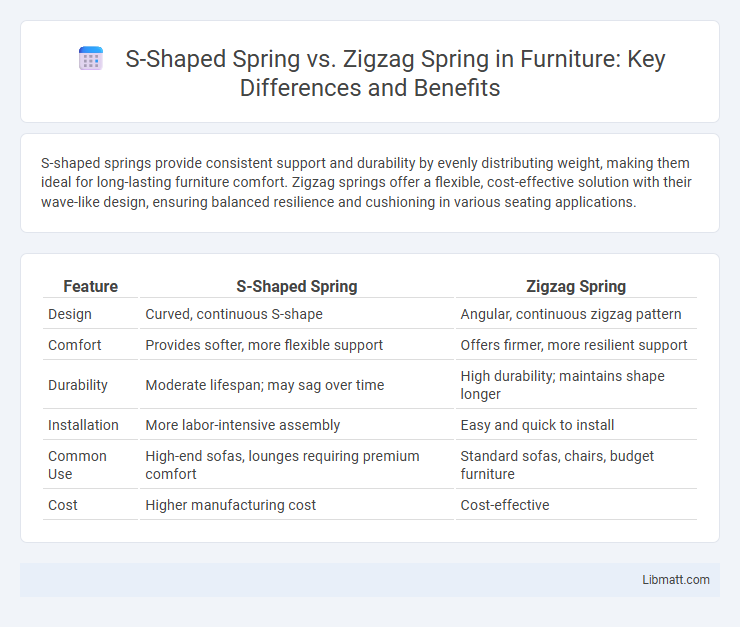S-shaped springs provide consistent support and durability by evenly distributing weight, making them ideal for long-lasting furniture comfort. Zigzag springs offer a flexible, cost-effective solution with their wave-like design, ensuring balanced resilience and cushioning in various seating applications.
Table of Comparison
| Feature | S-Shaped Spring | Zigzag Spring |
|---|---|---|
| Design | Curved, continuous S-shape | Angular, continuous zigzag pattern |
| Comfort | Provides softer, more flexible support | Offers firmer, more resilient support |
| Durability | Moderate lifespan; may sag over time | High durability; maintains shape longer |
| Installation | More labor-intensive assembly | Easy and quick to install |
| Common Use | High-end sofas, lounges requiring premium comfort | Standard sofas, chairs, budget furniture |
| Cost | Higher manufacturing cost | Cost-effective |
Introduction to S-Shaped Springs and Zigzag Springs
S-shaped springs, commonly found in upholstered furniture, offer enhanced comfort and durability by providing consistent support through their curved design. Zigzag springs, also known as serpentine springs, consist of continuous steel wire bent into a zigzag pattern, providing flexible and cost-effective support in seating applications. Both spring types are integral to furniture suspension systems, with S-shaped springs delivering more elasticity and zigzag springs favored for their ease of installation and structural strength.
Structural Differences: S-Shaped vs. Zigzag Springs
S-shaped springs feature a continuous curved design resembling the letter "S," providing uniform support and enhanced flexibility through their smooth bends. Zigzag springs are constructed from wire bent at sharp angles forming a series of connected "V" shapes, offering firmer support and increased durability due to their rigid structure. The structural difference impacts tension distribution, with S-shaped springs delivering more elasticity and zigzag springs ensuring greater stability in furniture applications.
Materials Used in S-Shaped and Zigzag Springs
S-shaped springs are typically crafted from high-carbon steel or tempered steel wire, ensuring superior elasticity and durability under consistent compression. Zigzag springs, often made from galvanized steel or stainless steel, provide enhanced corrosion resistance and flexibility, suitable for varied seating applications. Your choice depends on the required strength, flexibility, and environmental exposure of the spring's final use.
Durability Comparison: S-Shaped vs. Zigzag Springs
S-shaped springs offer superior durability due to their robust coil design that evenly distributes weight and resists deformation over time, making them ideal for high-traffic furniture. Zigzag springs, while offering flexible support, tend to wear out faster because their continuous wire construction is more susceptible to stretching and sagging. You should consider S-shaped springs for long-lasting comfort and consistent performance in your seating furniture.
Comfort Level: S-Shaped Spring vs. Zigzag Spring Support
S-shaped springs provide targeted support by conforming to body contours, enhancing comfort through consistent pressure distribution. Zigzag springs, though durable and cost-effective, deliver firmer support and less adaptive comfort due to their linear, interconnected design. Choosing an S-shaped spring can improve your mattress's comfort level by offering balanced support tailored to your body's natural shape.
Installation and Maintenance Considerations
S-shaped springs offer easier installation due to their uniform shape, allowing seamless integration into mattress frames without specialized tools. Zigzag springs require precise alignment and can be more challenging to install because of their angled design, increasing the risk of improper tension and wear. Maintenance of S-shaped springs is generally simpler, as their consistent structure reduces the likelihood of deformation, whereas zigzag springs may need more frequent checks to prevent sagging and ensure even support.
Cost Comparison: Which Spring is More Affordable?
S-shaped springs typically have a higher manufacturing cost due to their complex design and the use of thicker, more durable materials, making them less affordable than zigzag springs. Zigzag springs are cost-effective and widely used in budget-friendly furniture because of their simpler construction and easier installation process. Your choice depends on balancing upfront cost with durability and comfort preferences.
Common Applications: Where Each Spring Excels
Zigzag springs, commonly found in furniture seats and backs, excel in providing firm support and durability for everyday use. S-shaped springs are preferred in upholstered furniture frames due to their enhanced flexibility and comfort, offering superior cushioning for prolonged sitting. Your choice between these springs can impact the overall comfort and lifespan of seating solutions based on their application.
Pros and Cons of S-Shaped Springs
S-shaped springs provide excellent cushioning and durability, commonly used in high-quality mattresses for consistent support and resilience. Their design offers better motion isolation compared to zigzag springs, reducing the transfer of movement across the bed. However, S-shaped springs tend to be more expensive and heavier, potentially affecting the overall mattress weight and cost, which may influence your purchasing decision.
Pros and Cons of Zigzag Springs
Zigzag springs offer flexibility and cost-effectiveness, making them ideal for budget-friendly furniture with moderate comfort levels. They tend to sag over time and provide less support compared to S-shaped springs, resulting in reduced durability and comfort. Their simple design allows for easy installation but limits overall resilience in high-usage seating applications.
S-shaped spring vs zigzag spring Infographic

 libmatt.com
libmatt.com